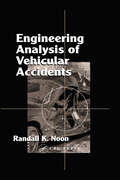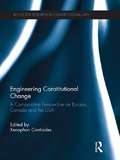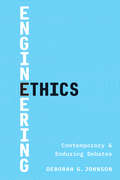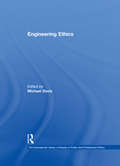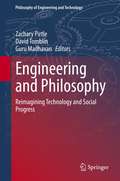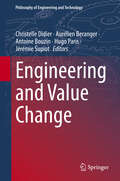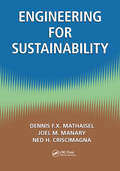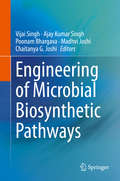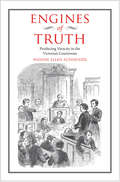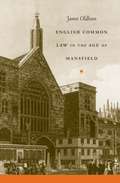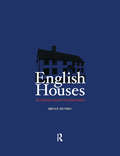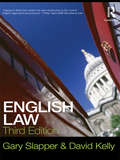- Table View
- List View
Engineering Analysis of Vehicular Accidents
by Randall K. NoonAccident analysis is not like a classroom problem where the equations are selected and solved, and the matter is considered closed. In this line of forensics, engineering skill must be combined with skillful practice for the successful presentation of evidence to a jury. In this book, the author demonstrates the application of engineering skills, methods, and judgment for analyzing vehicular accidents. A definition of vehicular accident reconstruction and its role in the legal system is provided. General accident statistics are cited, and some general strategies for accident reconstruction are given, along with many examples and case studies. The author includes novel and unusual treatment of the momentum method and coefficient of restitution (which is not yet widespread in accident analysis) and shows how to select the best methods of analysis in a given accident reconstruction.
Engineering Constitutional Change: A Comparative Perspective on Europe, Canada and the USA (Routledge Research in Constitutional Law #52)
by Xenophon ContiadesThis volume provides a holistic presentation of the reality of constitutional change in 18 countries (the 15 old EU member states, Canada, Switzerland and the USA). The essays offer analysis on formal and informal constitutional amendment bringing forth the overall picture of the parallel paths constitutional change follows, in correlation to what the constitution means and how constitutional law works. To capture the patterns of constitutional change, multi-faceted parameters are explored such as the interrelations between form of government, party system, and constitutional amendment; the interplay between constitutional change and the system of constitutionality review; the role of the people, civil society, and experts in constitutional change; and the influence of international and European law and jurisprudence on constitutional reform and evolution. In the extensive final, comparative chapter, key features of each country’s amendment procedures are epitomized and the mechanisms of constitutional change are explained on the basis of introducing five distinct models of constitutional change. The concept of constitutional rigidity is re-approached and broken down to a set of factual and institutional rigidities. The classification of countries within models, in accordance with the way in which operative amending mechanisms connect, leads to a succinct portrayal of different modes of constitutional change engineering. This book will prove to be an invaluable tool for approaching constitutional revision either for theoretical or for practical purposes and will be of particular interest to students and scholars of constitutional, comparative and public law.
Engineering Ethics: Contemporary and Enduring Debates
by Deborah G. JohnsonAn engaging, accessible survey of the ethical issues faced by engineers, designed for students The first engineering ethics textbook to use debates as the framework for presenting engineering ethics topics, this engaging, accessible survey explores the most difficult and controversial issues that engineers face in daily practice. Written by a leading scholar in the field of engineering and computer ethics, Deborah Johnson approaches engineering ethics with three premises: that engineering is both a technical and a social endeavor; that engineers don&’t just build things, they build society; and that engineering is an inherently ethical enterprise.
Engineering Ethics: Studies In The Ethics Of A Profession (The International Library of Essays in Public and Professional Ethics)
by Michael DavisThis volume is a collection of articles published since engineering ethics developed a distinct scholarly field in the late 1970s that will help define the field of engineering ethics. Among the perennial questions addressed are: What is engineering (and what is engineering ethics)? What professional responsibilities do engineers have and why? What professional autonomy can engineers have in large organizations? What is the relationship between ethics and codes of ethics and how should engineering ethics be taught?
Engineering and Philosophy: Reimagining Technology and Social Progress (Philosophy of Engineering and Technology #37)
by Guru Madhavan Zachary Pirtle David TomblinEngineers love to build “things” and have an innate sense of wanting to help society. However, these desires are often not connected or developed through reflections on the complexities of philosophy, biology, economics, politics, environment, and culture. To guide future efforts and to best bring about human flourishment and a just world, Engineering and Philosophy: Reimagining Technology and Progress brings together practitioners and scholars to inspire deeper conversations on the nature and varieties of engineering. The perspectives in this book are an act of reimagination: how does engineering serve society, and in a vital sense, how should it.
Engineering and Value Change (Philosophy of Engineering and Technology #48)
by Christelle Didier Aurélien Béranger Antoine Bouzin Hugo Paris Jérémie SupiotThis volume consists of chapters derived from the best papers submitted to the 2023 Forum on Philosophy, Engineering, and Technology (fPET) meeting that took place in April 2023 at Delft University of Technology. Topics and fields covered within the volume include applied ethics, meta-ethics, value theory, education, responsible innovation, political philosophy and value-sensitive design. The contributors present research that addresses the challenges of engineering in a changing world. This text is of interest to students and researchers working in the fields of engineering and philosophy.
Engineering for Sustainability
by Dennis F.X. Mathaisel Joel M. Manary Ned H. CriscimagnaSustainability and sustainable development have become popular goals. They have also become wide-ranging terms that can be applied to any entity or enterprise on a local or a global scale for long time periods. As enterprises and systems become more complex and development a support costs increase, the question remains: how does one engineer an ent
Engineering in Translational Medicine
by Weibo CaiThis book covers a broad area of engineering research in translational medicine. Leaders in academic institutions around the world contributed focused chapters on a broad array of topics such as: cell and tissue engineering (6 chapters), genetic and protein engineering (10 chapters), nanoengineering (10 chapters), biomedical instrumentation (4 chapters), and theranostics and other novel approaches (4 chapters). Each chapter is a stand-alone review that summarizes the state-of-the-art of the specific research area. Engineering in Translational Medicine gives readers a comprehensive and in-depth overview of a broad array of related research areas, making this an excellent reference book for scientists and students both new to engineering/translational medicine and currently working in this area. The ability for engineering approaches to change biomedical research are increasing and having significant impact. Development of basic assays and their numerous applications are allowing for many new discoveries and should eventually impact human health. This book brings together many diverse yet related topics to give the reader a solid overview of many important areas that are not found together elsewhere. Dr. Weibo Cai has taken great care to select key research leaders of many sub-disciplines who have put together very detailed chapters that are easy to read yet highly rich in content. _______________ This book brings together many diverse yet related topics to give the reader a solid overview of many important areas that are not found together elsewhere. Dr. Weibo Cai has taken great care to select key research leaders of many sub-disciplines who have put together very detailed chapters that are easy to read yet highly rich in content. It is very exciting to see such a great set of chapters all together to allow one to have a key understanding of many different areas including cell, gene, protein, and nano engineering as well as the emerging field of theranostics. I am sure the readers will find this collection of important chapters helpful in their own research and understanding of how engineering has and will continue to play a critical role in biomedical research and clinical translation Sanjiv Sam Gambhir M. D. , Ph. D. Stanford University, USA Engineering in Translational Medicine is a landmark book bridging the fields of engineering and medicine with a focus on translational technologies and methods. In a single, well-coordinated volume, this book brings together contributions from a strong and international scientific cast, broadly covering the topics. The book captures the tremendous opportunities made possible by recent developments in bioengineering, and highlights the potential impact of these advances across a broad spectrum of pressing health care needs. The book can equally serve as a text for graduate level courses, a reference source, a book to be dipped into for pleasure by those working within the field, or a cover-to-cover read for those wanting a comprehensive, yet readable introduction to the current state of engineering advances and how they are impacting translational medicine Simon R. Cherry, Ph. D. University of California, Davis, USA
Engineering of Microbial Biosynthetic Pathways
by Ajay Kumar Singh Vijai Singh Poonam Bhargava Madhvi Joshi Chaitanya G. JoshiThis book provides a comprehensive overview of the basic and advanced metabolic engineering technologies used to generate natural metabolites and industrially important biomolecules. Metabolic engineering has the potential to produce large quantities of valuable biomolecules in a renewable and sustainable manner by extending or modifying biosynthetic pathways in a wide range of organisms. It has been successfully used to produce chemicals, drugs, enzymes, amino acids, antibiotics, biofuels, and industrially important pharmaceuticals. The book comprehensively reviews the various metabolites detection, extraction and biosensors and the metabolic engineering of microbial strains for the production of industrially useful enzymes, proteins, organic acids, vitamins and antibiotics, therapeutics, chemicals, and biofuels. It also discusses various genetic engineering and synthetic biology tools for metabolic engineering. In closing, the book discusses ethical, patenting and regulatory issues in the metabolic engineering of microbes. This book is a valuable source not only for beginners in metabolic engineering, but also students, researchers, biotechnology and metabolic engineering based company.
Engines of Anxiety: Academic Rankings, Reputation, and Accountability
by Michael Sauder Wendy Nelson EspelandStudents and the public routinely consult various published college rankings to assess the quality of colleges and universities and easily compare different schools. However, many institutions have responded to the rankings in ways that benefit neither the schools nor their students. In Engines of Anxiety, sociologists Wendy Espeland and Michael Sauder delve deep into the mechanisms of law school rankings, which have become a top priority within legal education. Based on a wealth of observational data and over 200 in-depth interviews with law students, university deans, and other administrators, they show how the scramble for high rankings has affected the missions and practices of many law schools. Engines of Anxiety tracks how rankings, such as those published annually by the U.S. News & World Report, permeate every aspect of legal education, beginning with the admissions process. The authors find that prospective law students not only rely heavily on such rankings to evaluate school quality, but also internalize rankings as expressions of their own abilities and flaws. For example, they often view rejections from “first-tier” schools as a sign of personal failure. The rankings also affect the decisions of admissions officers, who try to balance admitting diverse classes with preserving the school’s ranking, which is dependent on factors such as the median LSAT score of the entering class. Espeland and Sauder find that law schools face pressure to admit applicants with high test scores over lower-scoring candidates who possess other favorable credentials. Engines of Anxiety also reveals how rankings have influenced law schools’ career service departments. Because graduates’ job placements play a major role in the rankings, many institutions have shifted their career-services resources toward tracking placements, and away from counseling and network-building. In turn, law firms regularly use school rankings to recruit and screen job candidates, perpetuating a cycle in which highly ranked schools enjoy increasing prestige. As a result, the rankings create and reinforce a rigid hierarchy that penalizes lower-tier schools that do not conform to the restrictive standards used in the rankings. The authors show that as law schools compete to improve their rankings, their programs become more homogenized and less accessible to non-traditional students. The ranking system is considered a valuable resource for learning about more than 200 law schools. Yet, Engines of Anxiety shows that the drive to increase a school’s rankings has negative consequences for students, educators, and administrators and has implications for all educational programs that are quantified in similar ways.
Engines of Truth
by Wendie Ellen SchneiderDuring the Victorian era, new laws allowed more witnesses to testify in court cases. At the same time, an emerging cultural emphasis on truth-telling drove the development of new ways of inhibiting perjury. Strikingly original and drawing on a broad array of archival research, Wendie Schneider's examination of the Victorian courtroom charts this period of experimentation and how its innovations shaped contemporary trial procedure. Blending legal, social, and colonial history, she shines new light on cross-examination, the most enduring product of this time and the "greatest legal engine ever invented for the discovery of truth. "
English Civil Justice after The Woolf and Jackson Reforms: A Critical Analysis
by John SorabjiJohn Sorabji examines the theoretical underpinnings of the Woolf and Jackson reforms to the English and Welsh civil justice system. He discusses how the Woolf reforms attempted, and failed, to effect a revolutionary change to the theory of justice that informed how the system operated. It elucidates the nature of those reforms, which through introducing proportionality via an explicit overriding objective into the Civil Procedure Rules, downgraded the court's historic commitment to achieving substantive justice or justice on the merits. In doing so, Woolf's new theory is compared with one developed by Bentham, while also exploring why a similarly fundamental reform carried out in the 1870s succeeded where Woolf's failed. It finally proposes an approach that could be taken by the courts following implementation of the Jackson reforms to ensure that they succeed in their aim of reducing litigation cost through properly implementing Woolf's new theory of justice.
English Common Law in the Age of Mansfield
by James OldhamIn the eighteenth century, the English common law courts laid the foundation that continues to support present-day Anglo-American law. Lord Mansfield, Chief Justice of the Court of King's Bench, 1756-1788, was the dominant judicial force behind these developments. In this abridgment of his two-volume book, The Mansfield Manuscripts and the Growth of English Law in the Eighteenth Century, James Oldham presents the fundamentals of the English common law during this period, with a detailed description of the operational features of the common law courts. This work includes revised and updated versions of the historical and analytical essays that introduced the case transcriptions in the original volumes, with each chapter focusing on a different aspect of the law.While considerable scholarship has been devoted to the eighteenth-century English criminal trial, little attention has been given to the civil side. This book helps to fill that gap, providing an understanding of the principal body of substantive law with which America's founding fathers would have been familiar. It is an invaluable reference for practicing lawyers, scholars, and students of Anglo-American legal history.
English Houses: An Estate Agent's Companion
by Bruce MunroThis book is essential reading for property professionals and laymen alike. Anyone who would like to know more about the houses of England’s cities, towns and villages will benefit from reading this book.Through a wealth of pictures, easy to read comments and architectural notes the book helps the reader to identify the different architectural periods and understand the development of the construction of English houses. The book illustrates a number of influential styles and features of English houses throughout history. Also included are examples of houses that have been altered by several generations and different periods enabling the reader to trace trends and discover the more subtle nuances of English houses.
English Law
by David Kelly Gary SlapperWhether you are engaged in the study of law, are considering studying law at university, are a business professional or want to find out more about the law in general, Slapper and Kelly's English Law offers a clear, lively and reliable point of entry to the law in England and Wales. Presented in an easy-to-read style, it provides readers with an accurate explanation of how the English legal system currently works and the content of English law in all its key areas of operation, including criminal law, contract law and the law of negligence. An invaluable introduction, English Law is an excellent resource for students of the English legal system and English law, as well as for professionals and general readers.
English Law in the Age of the Black Death, 1348-1381
by Robert C. PalmerRobert Palmer's pathbreaking study shows how the Black Death triggered massive changes in both governance and law in fourteenth-century England, establishing the mechanisms by which the law adapted to social needs for centuries thereafter. The Black Death killed one-third of the English population between 1348 and 1351. To preserve traditional society, the king's government aggressively implemented new punitive legal remedies as a mechanism for social control. This attempt to shore up traditional society in fact transformed it. English governance now legitimately extended to routine regulation of all workers, from shepherds to innkeepers, smiths, and doctors. The new cohesiveness of the ecclesiastical and lay upper orders, the increase in subject matter jurisdictions, the growth of the chancellor's court, and the acceptance of coercive contractual remedies made the Black Death in England a transformative experience for law and for governance. Palmer's book, based on all of the available legal records, establishes a genuinely new interpretation and chronology of these important legal changes.
English Law, the Legal Profession, and Colonialism: Histories, Parallels, and Influences (Routledge Studies in Comparative Legal History)
by Cerian Griffiths Łukasz Jan KorporowiczModern legal history is increasingly interested in exploring the development of legal systems from novel and nuanced approaches. This edited collection harnesses the lesser-researched perspectives of the impact of global and imperial factors on the development of law. It is argued that to better understand these timely discussions, we must understand the process and significance of colonisation itself. The volume brings together experts in the field of law and history to explore the ways in which law and lawyers contributed to the expansion of the British Empire, and the ways in which the Empire influenced the Metropole. The book sheds new light on the role of the law and legal actors during the pivotal centuries that saw the establishment of the Empire. Exploring such topics as Atlantic relations, the impact of British jurists upon Indian law, and the development of the law settler colonies, this collection reveals some of the lesser-known intersections between law, history, and empire. The book will be of interest to students and researchers in legal history, comparative history, equity and trusts, contract law, the legal profession, slavery, and the British Empire.
English Law, the Legal Profession, and Colonialism: Histories, Parallels, and Influences (Routledge Studies in Comparative Legal History)
by Cerian Griffiths Łukasz Jan KorporowiczModern legal history is increasingly interested in exploring the development of legal systems from novel and nuanced approaches. This edited collection harnesses the lesser-researched perspectives of the impact of global and imperial factors on the development of law. It is argued that to better understand these timely discussions, we must understand the process and significance of colonisation itself. The volume brings together experts in the field of law and history to explore the ways in which law and lawyers contributed to the expansion of the British Empire, and the ways in which the Empire influenced the Metropole. The book sheds new light on the role of the law and legal actors during the pivotal centuries that saw the establishment of the Empire. Exploring such topics as Atlantic relations, the impact of British jurists upon Indian law, and the development of the law settler colonies, this collection reveals some of the lesser-known intersections between law, history, and empire. The book will be of interest to students and researchers in legal history, comparative history, equity and trusts, contract law, the legal profession, slavery, and the British Empire.
English Legal System (Key Facts Key Cases)
by Jacqueline MartinKey Facts Key Cases: English Legal System will ensure you grasp the main concepts of your English Legal System module with ease. This book explains in concise and straightforward terms: • Discussion of the courts system, both civil and criminal; • Details of the tribunal system• The doctrine of precedent• Statutory interpretation• Personnel in the legal system, both professional and lay Key Facts Key Cases is the essential series for anyone studying law at LLB, postgraduate and conversion courses and professional courses such as ILEX. The series provides the simplest and most effective way to absorb and retain all of the material essential for passing your exams. Each chapter includes: diagrams at the start of chapters to summarise key points structured headings and numbered points to allow for clear recall of the essential points charts and tables to break down more complex information Where relevant, chapters also contain a Key Cases section which provides the simplest and most effective way to absorb and memorise essential cases needed for exam success. Essential and leading cases are explained The style, layout and explanations are user friendly Cases are broken down into key components by use of a clear system of symbols for quick and easy visual recognition
English Legal System (Spotlights)
by Frances Burton Ryan MurphyThis book offers a modern, contemporary and innovative approach to the core curriculum, offering clear explanations to clarify the material without oversimplification. Carefully developed learning tools are used to help students to build their knowledge of the legal system of England and Wales; moreover, all the materials needed by a reader new to legal education are here in one place.English Legal System will also help students to translate knowledge successfully to an assessment situation (whether examination, tutorial preparation or coursework) through the acquisition and development of key skills such as problem solving and application, critical reasoning and evaluation, and research and referencing. The text has been written with the changes to legal education envisaged by the Solicitors Regulation Authority and Bar Standards Board in mind.The focus throughout will be on recent and key case law and contemporary real-life examples, bringing the subject alive and helping students to understand the foundations on which the law in England and Wales is based. The key pedagogic features seek to embed those legal skills within the context of the content on the legal system. The associated website provides a comprehensive learning environment that will provide further illumination of the text and graphics and that caters for a number of different learning styles with additional video and audio content.
English Legal System Eighth Edition
by Jacqueline MartinSupport your students with this accessible and authoritative introductory textbook for the English Legal System - from the author and publisher you trust.Written by Jacqueline Martin, who has helped hundreds of thousands pass their exams and enjoy their studies, The English Legal System, 8th edition ensures that students have a comprehensive understanding of this area of the Law. It maintains a balance between deep insight and easy reading so students can reach their highest potential.The text supports a range Law courses, including OCR and WJEC A Level, ILEX, Access to HE, paralegal, international foundation programme, BTEC in Applied Law, law courses for non-law students in business, accountancy and public services plus Foundation Degree and LLB programmes.- Use diagrams, illustrations, key facts charts and activities to clarify difficult concepts and help students remember the key information- Support understanding and revision with key terms, a glossary for quick reference and examination advice- Hold your students' attention with interesting and informative cases and explanations of the law- Encourage students to question the logic and practicality of the law in England and Wales
English Legal System Lawcards 2012-2013 (Lawcards)
by RoutledgeRoutledge Lawcards are your complete, pocket-sized guides to key examinable areas of the undergraduate law curriculum and the CPE/GDL. Their concise text, user-friendly layout and compact format make them an ideal revision aid. Helping you to identify, understand and commit to memory the salient points of each area of the law, shouldn’t you make Routledge Lawcards your essential revision companions? Fully updated and revised with all the most important recent legal developments, Routledge Lawcards are packed with features: Revision checklists help you to consolidate the key issues within each topic Colour coded highlighting really makes cases and legislation stand out Full tables of cases and legislation make for easy reference Boxed case notes pick out the cases that are most likely to come up in exams Diagrams and flowcharts clarify and condense complex and important topics '...an excellent starting point for any enthusiastic reviser. The books are concise and get right down to the nitty-gritty of each topic.' - Lex Magazine Routledge Lawcards are supported by a Companion Website offering: Flashcard glossaries allowing you to test your understanding of key terms and definitions Multiple Choice Questions to test and consolidate your revision of each chapter Advice and tips to help you better plan your revision and prepare for your exams Titles in the Series: Commercial Law; Company Law; Constitutional Law; Contract Law; Criminal Law; Employment Law; English Legal System; European Union Law; Evidence; Equity and Trusts; Family Law; Human Rights; Intellectual Property Law; Jurisprudence; Land Law; Tort Law
English, French & German Comparative Law
by Raymond YoungsThis comparative analysis considers the differing approaches to important areas of law in England, France and Germany. In particular, constitutions, sources of law, rights against the state to prevent abuse of power, and rights of private individuals and organisations against each other in tort and contract are examined and compared, and the system of courts is also considered. Updated and revised, each sub-topic is introduced with the relevant material in the English system, allowing easy comparison and assimilation of the other systems. The text includes translations of relevant French and German codal material, and references to relevant cases from all of the jurisdictions. This new edition includes constitutional changes in France and the United Kingdom, in particular the new procedure for challenging existing legislation before the Conseil constitutionnel. It examines the consequences of the Lisbon Treaty, as well as other recent codal and legislative changes. Comprehensive and topical, the text explores a wide variety of new case law on issues such as: preventive detention; the use of evidence obtained by torture; the balance between suppression of terrorism and personal freedom; the internet; email monitoring; artificial reproductive techniques; use of global positioning systems (GPSs), deoxyribonucleic acid (DNA) and closed-circuit television (CCTV); the wearing of religious clothing (such as the headscarf) and symbols (such as the cross); circumcision; methods of crowd control; the prevention of human trafficking; the preservation of privacy, especially for celebrities; and the legality of pre-nuptial agreements and success fees for lawyers. Designed for students on comparative law courses, this textbook will also prove valuable to students who are familiar with English law, but require a readily comprehensible introduction to French or German law.
Enhanced Beings: Human Germline Modification and the Law
by Kerry Lynn MacintoshToday, scientists are using CRISPR/Cas9 and other molecular editing tools to alter human gametes and embryos, a practice known as human germline modification. In the near future, these efforts may lead to the birth of children with better health, improved memories, and extended lifespans. However, critics claim that human germline modification exceeds divine and natural boundaries, transforms reproduction into manufacture, and yields apocalyptic outcomes such as the collapse of democracy. Enhanced Beings: Human Germline Modification and the Law analyzes and critiques these objections on both biological and political grounds. Professor Kerry Lynn Macintosh discusses the hidden psychology behind the objections, and describes the laws that affect this new technology. Provocative and timely, Enhanced Beings argues that bans on human germline modification pose a threat to scientists and science, parents, children, foreigners, and society.
Enhanced Dispute Resolution through the Use of Information Technology
by Arno R. Lodder John ZeleznikowAlternative Dispute Resolution has now supplanted litigation as the principal method of dispute resolution. This overview of dispute resolution addresses practical developments in areas such as family law, plea bargaining, industrial relations and torts. The authors elaborate on the necessary legal safeguards that should be taken into account when developing technology-enhanced dispute resolution and explore a wide range of potential applications for new information technologies in dispute resolution.
